QUALITY SEED PRODUCTION IN BITTERGOURD
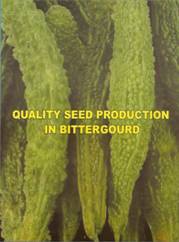
Selection of land for quality seed production
The selection of land is the first and foremost task for a seed producer. The seed production plot must be selected carefully. A fertile and healthy seed plot will certainly produce quality seed. The field selected for seed production must not have been sown with bitter gourd in the previous season. This is done to avoid volunteer plants that cause admixture.
What are volunteers?
Volunteers are plants that grow in the field from the seeds found in the soil. These seeds should have been fallen from previous season crop. As they germinate without sowing or they volunteer to grow by themselves, hence the name volunteer plants.
Soil with neutral pH must be selected. Loam or clay loam soils are best suited. Higher organic matter will lead to production of vigorous seed.
Isolating the seed crop to avoid genetic contamination
The quality seed must be genetically and physically pure. Genetic purity can be maintained by preventing cross pollination with other undesirable varieties. This is achieved by isolating the seed crop.
Isolation is the act of growing the seed crop away from a contaminant such that cross pollination is prevented. Bittergourd is a highly cross pollinated crop because flowering is monoecious in nature. Hence it requires 500 m (1500 feet) away from another variety of bittergourd.
Selecting the right season for raising seed crop
Seed is very sensitive to weather. Hence selecting the right season is necessary. Through bittergourd can be grown through out the year, seed crop should be grown such that the seed matures in cool dry climate. This will facilitate proper ripening of fruits and reduce the pest and disease infection. Seasons are selected with this idea in mind. In Tamil Nadu the best seed crop growing seasons are Aadi and Thai Pattam i.e. June – July and January – February.
Seed selection
Selecting ripe and vigorous seed is the first step in the production of robust seedling which will ultimately lead to producing quality seed. Planting robust seedling will impart disease and pest resistance and help in proper uptake of precious fertilizer applied to the main field. Proper care must be taken to avoid the usage of aged seeds are stored for more than a year.
Selection of seed is the first step in production of quality seed. This involves selection of seeds with the right genetic make-up of the variety chosen to be produced. Seeds must be from an approved source. This is possible if the seed is got from the breeding firm / university research station or from the breeder himself. Verify if the seed brought for sowing has breeder seed tag (for producing foundation seed); foundation seed tag (for production of certified seed). Further, the seeds must be free from pest and diseases. Rotten, dull coloured, black spotted seeds must be removed. Seeds of uniform size and shape alone must be used for sowing.
Preparation of main field and sowing
After proper ploughing, at a spacing of 2.5 x 2 m distance take pits having 45 cm length, width and height. Ten days after that, apply 10 kg FYM and ura 13 g, super phosphate 72 g and potash 19 g per pit. Then mix the above nutrients with soil and fill the pits and level them. Since, it is vining in nature better to erect the pandal at 2 m height or we can tie wires at a distance of one foot horizontally and connect those lines by tieing the wires vertically at same spacing. It will facilitate for better growth and yield and also easy for rouging operation.
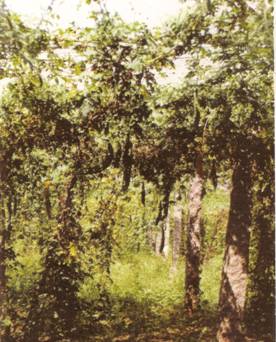
Bitter gourd pandal
Sowing
Generally, germination of bittergourd seeds in the field is less and also delayed. This results in non uniformity in plant growth and fruit maturation. This can be over come by using pre germinated seeds.
For pre germination, the bittergourd seeds should be soaked in water for 24 hours. Then soaked seeds is to be mixed with double the volume of moist sand and seed should be fully covered by the sand and keep it for three days. During this period moisture of sand should be maintained. After that, the seeds with radicle emergence are to be collected and used for sowing.
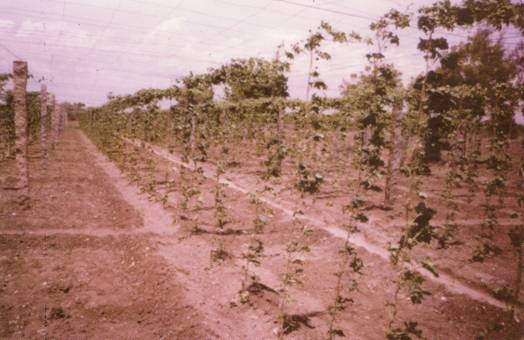
Spreading of bitter gourd vines in the trellis
Seeds of 1.8 kg pre germinated seeds required for an acre may be sown in a pit with three seeds at equal distance. If we are using pre-germinated seeds, sow only three seeds per pit.
Irrigation management
After sowing pits should be irrigated with water. Care must be taken that the soil should not be eroded and seed should not be exposed. After the seedling emergence, field should be irrigated once in a week.
Main field maintenance
Ten days after the germination, retain one vigorous seedling per pit and remove two seedlings. It will facilitate for better growth of seedling without any competition between them. 20-25 days after sowing, each plant has to be provided with stacking for trailing the vines over the pandal. Trailing operation has to be carried out daily until the fruiting stage.
Controlling weed
Maintaining the field free of weed is more important for the crop growth. In bittergourd, one or two manual weeding is necessary before the flowering stage.
Growth regulator spray
Generally in cucurbitaceous vegetables the male and female flowers are born separately. The number of female flowers decides the fruit yield. Hence, for bittergourd, spraying of ethrel at 200 ppm for four times starting from 15 days after sowing and followed by weekly intervals (i.e. 2.0 ml of ethrel in 10 lit of water). This facilitates for higher fruit yield.
Top dressing
Seed crop is entirely different from vegetable crop. Hence, fertilizer is applied as two or three split doses. Two split dose of urea as 22 g/pit at flowering stage and another 18 g urea plus 5 g potash / pit each at 20 and 40 and quality seed yield.
Maintaining seed quality by rouging
One of the most important aspects of seed production is thorough rouging. Rogue is defined as of those plants that deviate from the characters described for the variety. Such rogues if left in the field they tend to reduce the genetic purity of the seed crop and thus reduce purchase value of resultant seed. Roguing is defined as the operation of removing rogues. In practice, all virus infected plants are to be removed.
When to do roguing ?
Roguing is more effective if done prior to flowering, since upon flowering there is very high possibility of cross pollination. Roguing is also attempted during vegetative phase, fruit formation stage and prior to harvest.
Roguing during vegetative phase
During vegetative phase, during first 30-35 days, rouging is attempted based on plant characters like height of plant, leaf shape, size, surface of leaf.. Plants showing heavy branching and spreading nature are removed. Plants showing variation in stem or leaf base colour are also removed. Those plants showing symptoms of yellow mosaic are also removed.
Roguing during fruit formation phase
At this phase, the rogues are removed based on fruit characteristics like length of fruit, size, shape and colour.
Roguing during fruit harvest phase
Roguing is done prior to harvest based on fruit colour and pests and diseases infection. While harvesting, the workers can be taught to separate infected fruit from good ones and forward only the uninfected fruits for seed extraction.
Harvesting
In bittergourd the harvest is not as that done is field crops as once over harvest. The harvests will be done in different pickings in biitergourd. Here the first and last one or two harvests may be taken for vegetable. The fruits harvested in between these harvests are used for seed extraction.

Fruits selected to extract seed
For seed purpose generally harvest will be done 5-7 days after the maturity of vegetables. Since, at that stage the seeds will attain its maturity. At that stage, there will be change in fruit colour to yellow at any portion of the fruit. After the harvest the fruits can be stored for one or two days for over and this will facilitate easy seed extraction. Fruits confirming the genetic purity with medium to large size fruits should alone be used for seed extraction. This selection and grading procedures will increase the yield of quality seed recovery.
Attention: We should not delay the harvest until the fruit colour completely change to red. Such delay leads to loss of seed due to split opening of fruits because of over ripening. Hence, fruit harvest should be done at a stage where there is a change in colour in any part of the fruit or ¼ th of the fruit turns to red colour.
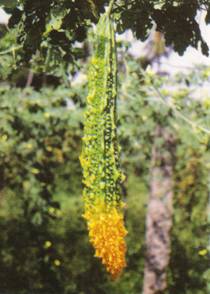
Optimum stage of harvest
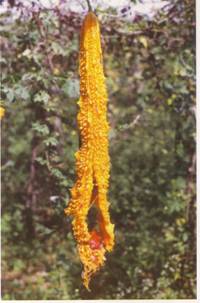
Damage caused due to delayed harvest
Processing to improve seed quality
After the fruit harvest and before the seed extraction, only healthy fruits of true to type and free from pest / disease infestation is to be selected for seed extraction.
Seed extraction method
Selected fruits are to be used for seed extraction. In bittergourd seed extraction is easy. Split open the fruits longitudinally and collect the seeds along with pulp. Crush the pulp with hands and wash with excess quantity of water to remove the pulp. The extracted seeds are to be dried properly.
It is easy to dry the seeds extracted by acid method and also remove the fungal growth over the seed coat, thus seeds possessing golden yellow colour and high vigour. The seed extracted by fermentation method posses poor vigour and off colour due to fungal activity.
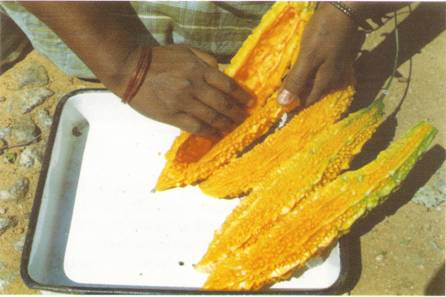
Separation of seeds
Seed drying
Immediately after seed extraction, it has to be properly dried, since seeds were extracted from 100% moist condition. The extracted seeds should spread on gunny bags in a thin layer and dried under shade for 8 to 10 hours for one or two days. Then, seeds can be dried under direct sunlight between 8 am 12 noon and 3 to 5 pm. Avoid drying in between 12 to 3 pm. since the rays emitting from sun and the heat may affect the seed viability. While drying care must be taken to avoid clogging.
The extracted seed should not be dried directly under sun. Since seed posses high moisture it may affect the germination potential. Similarly, while drying frequent stirring is more important otherwise it leads to clogging. This may results in improper drying, fungus growth and poor vigour.
Seed cleaning and processing
After proper drying seeds have to be processed. By removing the ill filled and small size seeds, vigiour and viability are improved. For bittergourd seed processing BSS 4 wire mesh sieve is to be used. After sieving, those seeds that are broken, fungal infected, seed coat damaged are removed.
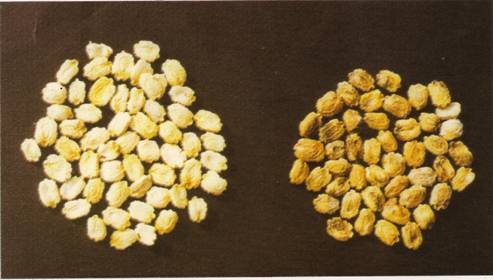
Good quality seeds Ill filled seeds
Protecting seeds during storage
Producing quality seeds is only half of the job, the other half is protecting the seed during its storage that starts after processing till it is sown by the farmer. The major aspects that impart good storability are adequate seed moisture, seed treatment, mid storage correction and seed storage container.
Seed moisture
Seed moisture is the foremost seed physical attribute that contributes for storage life. Lower the seed moisture, longer the shelf life. Short term storage can be achieved by drying the seeds to 7-8% moisture content while long term storage is possible by reducing the seed moisture even further to 6%. Under such low moisture content, seeds have to be stored in moisture proof bags made of thick polythene (700 guage).
Seed treatment
Prior to storage, seeds are treated with fungicide to ward off fungal pathogens. Seeds are mixed with Carbendazim 4g/kg. A novel technique called Halogen permeation treatment is also recommended now-a-days. Calcium oxy-chloride, commercially known as bleaching power and powdered calcium carbonate (lime stone) is mixed in equal ratio. This mixture is added to seed 5g/kg and stored.
Seed container
Apart from seed and seed treatment, the next most important aspect of seed storage is seed container. Container can be chiefly differentiated as moisture pervious and moisture impervious types. Cloth, paper and gunny bags are moisture pervious as the moisture from outside atmosphere can enter and exit freely. Hence, even if the seed is dried to safe moisture, but stored in humid climate, then seed gain moisture during storage and looses vigour. So, to safely store seeds in moisture previous bag, the outside humidity must be low. In Tamil Nadu, most of the months are hot and humid, hence after drying the seed to safe moisture limit, seeds can be safely stored in moisture impervious bag like thick polythene bags of 700 g or in tin / plastic containers that are sealed tightly. In case of short term storage (4-6 months) cloth or gunny will be sufficient.
Seed certification
Seed certification will give guarantee for genetic purity and other qualities. It is a legally sanctioned system for quality seed production. The supply of improved varietal seed to the farmers with high genetic purity, physical purity and germinability are being the main objectives of the seed certification.
Seed certification acts at different stages from sowing to issue the tags and sealing the bags. They start their function by verifying the seed source before the seeds are sown, then verifying the isolation distance followed for that seed crop, taking field inspections at different stages viz., bagging operations. In addition to these operations, it is their duty to send samples to seed testing laboratory and after receiving the results, they will be issuing the certification tags.
The seeds so produced will be issued certification tag only after meeting out the prescribed field and seed standards.
Hence, by registering the seed production fields under seed certification we could able to produce genetically as well as physically pure seeds. The private seed producers can also subject their seed production fields under seed certification for quality seed distribution.
For more details contact the seed certification officers nearby area.
Minimum seed certification standards prescribed for certified seed
Field standards |
|
Rogues (maximum limit) |
0.2% |
Seed standards |
|
Pure seeds (minimum limit) |
98.0% |
Inert matter (maximum limit) |
2.0% |
Other crop seed (maximum limit) |
None |
Other varietal seeds (max) |
10/kg |
Weed seeds (maximum limit) |
None |
Objectionable weed seeds (max) |
None |
Germination (minimum limit) |
60.0% |
Moisture |
|
Moisture proof bag |
6.0% |
Moisture pervious bag |
7.0% |
|








